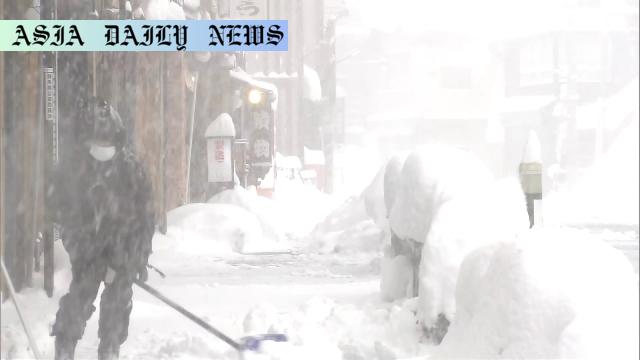winter cold: Japan faces heavy snowfall impacting Hokkaido, Honshu, and low-lying regions, urging caution against avalanches and disruptions.
- Key Point 1: Japan faces severe winter cold, with heavy snowfall hitting Hokkaido and Honshu.
- Key Point 2: Accumulated snowfall exceeds 4.85 meters in some areas, disrupting daily life.
- Key Point 3: Meteorological Agency urges caution against traffic disruptions, avalanches, and power outages.

Severe Winter Conditions Hit Japan
Japan is currently dealing with severe winter conditions, as a strong cold air mass combined with a winter pressure pattern has brought heavy snowfall to various regions of the country. According to the Japan Meteorological Agency, areas along the Sea of Japan coastline, including parts of Hokkaido and Honshu, have been significantly impacted. Low-lying regions, such as the Kinki and Tokai areas, are also experiencing unusual snowfall levels, adding to concerns about traffic disruptions, avalanches, and other associated risks.
Massive Snowfall Accumulation Across Regions
In Hokkaido and the mountainous regions of Honshu, snowfall has reached unprecedented levels. Yuzawa Town in Niigata Prefecture recorded 60 centimeters of snowfall over 24 hours, while Shirakawa Village in Gifu Prefecture reported 55 centimeters in the same period. Even low-lying areas are not untouched, with 29 centimeters of snow accumulating in Toyama City and 12 centimeters in Hikone City, Shiga Prefecture, as of Wednesday evening.
The Hakkoda mountain range in Aomori Prefecture has experienced some of the heaviest snowfall, with Sukayu recording an astounding 4.85 meters of snow. Similarly, Tsunan Town in Niigata Prefecture reported 3.54 meters of accumulation. This level of snowfall poses significant challenges, not only for residents and local authorities but also for transportation and power infrastructure.
Worsening Conditions Ahead
While the Meteorological Agency forecasts a gradual weakening of the cold air mass in western Japan, the Sea of Japan side of northern Japan is expected to face localized intensification of snowfall in the coming days. By the weekend, snowfall may escalate further, heightening risks for the affected regions. The winter pressure pattern shows no immediate signs of dissipating, ensuring that vigilant monitoring and preparedness are essential in the days ahead.
Advisories and Precautions
The Meteorological Agency has issued stern warnings about potential hazards resulting from the heavy snow. Residents are urged to remain cautious of traffic disruptions on icy or snow-covered roads, power outages caused by fallen tree branches due to the weight of the snow, and the risk of avalanches in mountainous regions. Local authorities are working to mitigate the impact by clearing snow from roads, restoring disrupted power lines, and maintaining communication with those in isolated areas.
Impact on Daily Life
The heavy snowfall has significantly disrupted daily life in affected areas. Commuting is increasingly challenging due to blocked roads and delayed public transport services. Some regions are experiencing power outages from downed power lines. Meanwhile, farmers in rural areas are struggling to protect their crops and livestock from the adverse weather conditions. Urban centers are also affected, with businesses facing reduced foot traffic and logistical delays caused by transportation bottlenecks.
Efforts toward Relief and Mitigation
Authorities and volunteer groups are working tirelessly to address the challenges posed by the severe weather. Emergency shelters have been established in vulnerable areas, and residents are being advised to stockpile essential supplies, such as food, water, and heating equipment. Additionally, advanced weather tracking systems are being utilized to predict and mitigate future weather disruptions. Despite ongoing efforts, the magnitude of the snowfall presents a daunting task for relief teams.
Looking Ahead
Japan’s winters are renowned for their harshness, but this year’s weather patterns demonstrate extreme levels of cold and snow. It serves as a stark reminder of the importance of preparation and adaptability in the face of natural disasters. Moving forward, coordinated efforts involving government agencies, local authorities, and residents will be crucial to minimizing the adverse effects of such weather events. With snow expected to intensify over the weekend, preparedness remains more critical than ever.



Commentary
The Severity of Japan’s Winter Challenges
The recent winter conditions in Japan reflect the sheer power of nature and highlight the challenges posed by extreme weather phenomena. Heavy snowfall in regions like Hokkaido and Honshu not only disrupts daily life but also raises urgent safety concerns. As we observe snowfall accumulation surpassing 4.85 meters in some areas, the need for efficient disaster response becomes evident. This event underscores the unpredictability of climate patterns in recent years and serves as a reminder of the necessity for preparedness.
Importance of Proactive Measures
What stands out in this situation is the resilience of local communities and the proactive measures taken by weather agencies and municipal authorities. From issuing advisories to mitigating risks of avalanches and fallen trees, Japan’s disaster management system demonstrates its capability to handle even the most demanding scenarios. However, the intensity of the current snowfall also suggests the ever-growing need to invest in more advanced meteorological technologies and infrastructure reinforcement.
Global Lessons from Japan’s Snowfall
The challenges Japan is confronting with this severe winter provide critical lessons for other countries across the globe that are prone to extreme weather conditions. Strengthening coordination between local governments, investing in community education, and improving early warning systems are steps every nation can take to mitigate potential risks. Ultimately, while nature’s forces can be overwhelming, effective preparedness and a quick response can significantly alleviate its impact.